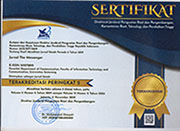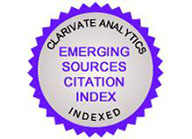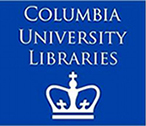Hashtag (#) as Message Identity in Virtual Community
Abstract
Computer Mediated Communication or CMC is able to present a virtual community, where the people inside have the same interest to share information related to events, activities, competitions, entertainment, history, event and others in Semarang City for publication. This research attempted to describe that hashtags can be utilized as the identity of a message in a communications network on Facebook Group MIK Semar. The results of this study are hashtags have changed how we build a virtual community, as the use of hashtags in Facebook Group MIK SEMAR as message identity to build better relationship and support communication among its members.
Keywords
Full Text:
PDFReferences
APJII. (2016). APJII: Infografis Penetrasi dan Perilaku Pengguna Internet di Indonesia. Retrieved from https://www.apjii.or.id/content/read/39/264/Survei-Internet-APJII-2016.
Bruns, A., Burgess, J.E. (2011). The Use of Twitter Hashtags in the Formation of ad hoc publics. The 6th European Consortium for Political Research General Conference. University of Iceland: Reykjavik.
Dey, I. (1993). Qualitative Data Analysis A User-Friendly Guide For Social Scientists. London and New York: Routledge-Taylor and Francis Group
Facebook. (2017). Peraturan Grup MIK Semar. Retrieved from https://web.facebook.com/groups/MIKSEMAR
Facebook. (2017). Peraturan Memakai Hashtags. Retrieved from https://web.facebook.com/groups/MIKSEMAR/permalink/1571344309649193/
Greenhalgh, T., Taylor, R. (1997). Papers that go Beyond Numbers (Qualitative Research). BMJ: British Medical Journal, 315 (7110), 740.
Hine, C. (2000). Virtual Ethnography. London: Sage.
Huberman, A.M., Miles, M.B. (2009). Qualitative Data Analysis, atau Analisis Data Kualitatif, terjemahan Tjetjep Rohendi. Jakarta: Univ. Indonesia Press.
Hutagalung, I. (2014). Etika dan Media Sosial dalam Masa Depan Komunikasi, Masa Depan Indonesia: Demokrasi Dalam Ruang Virtual. Jakarta: ISKI.
McQuail, D. (2011). Teori Komunikasi Massa McQuail (Edisi 6 Buku 1). Jakarta: Salemba Humanika
Kaplan, A.M., Haenlein, M. (2010). Users of the world, unite! The challenges and opportunities of Social Media. Business Horizons.
Kriyantono, R. (2007). Teknik Praktis Riset Komunikasi. Jakarta: Kencana Prenada Media Group.
Thurlow et al. (2007). Computer Mediated Communication: Social Interaction and the Internet. London: Sage Publication.
Ubayasiri, K. (2006). Internet and the Public Sphere: A Glimpse of YouTube. JOUR., 2. Central Queensland University.
Watie, E.D.S. (2011). Komunikasi dan Media Sosial (Communications and Social Media). Jurnal The Messenger, 3 (2), 69 74.
Watie, E.D.S. (2012). Media Sosial yang Dibenci yang Ditakuti. Jurnal The Messenger, 4 (2), 14 18.
DOI: http://dx.doi.org/10.26623/themessenger.v10i1.671
Refbacks
- There are currently no refbacks.
Copyright (c) 2018 Jurnal The Messenger
View My Stats [Jurnal The Messenger] is an International Scientific Journal, Published by the Department of Communication, Faculty of Information Technology and Communication, Universitas Semarang (Central Java, Indonesia). It is licensed under a Creative Commons Attribution 4.0 International License.



_11.jpg)




_BARCODE.jpg)
_BARCODE1.jpg)



5.png)










2.png)





